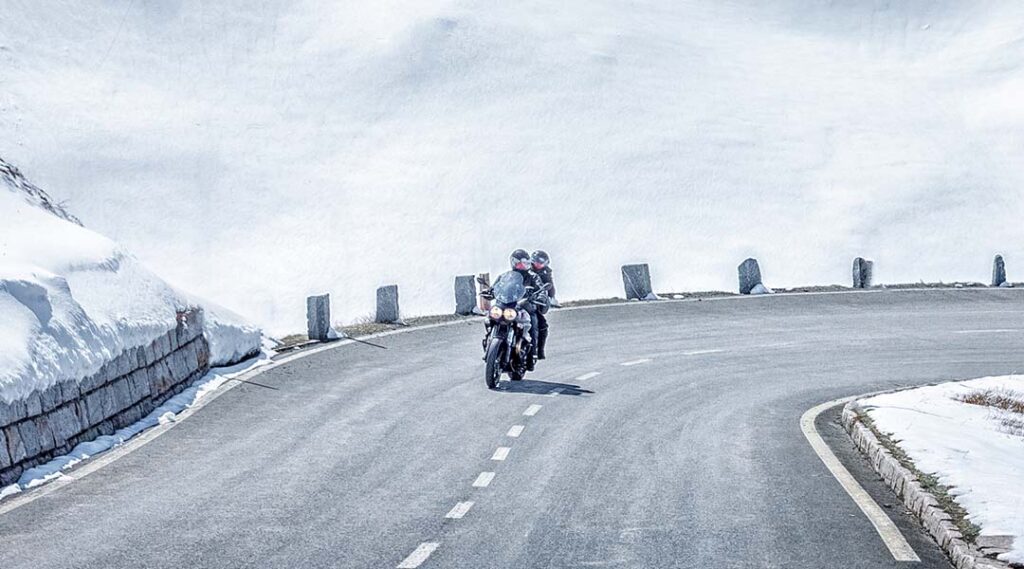This post was originally published on www.progressive.com
Many motorcyclists are three-season riders, especially those farther north. But year-round riding is possible if you keep the challenges and risks of cold-weather motorcycle riding in mind. You’ll need special gear to ward off the adverse weather conditions you’ll face. It’s also a good idea to get your bike checked by a mechanic to see if it’s ready for cold-weather riding before you set out.
Preparation for riding a motorcycle in the snow
Before you get out on the road, there are a few things you should do to make sure you and your bike are ready.
Check your bike for winter conditions
Most bikes are set up for three-season riding and therefore have fluids and batteries suited to warmer weather. Cold temperatures make it harder to start the bike. Batteries don’t function as well in the cold. When you start the bike in the cold, it must work harder to move because the oil is thicker when temperatures are low. If your bike struggles to start in cold weather, you may need to replace the battery with one better suited to cold starts. Similarly, check what oil is in the bike, and talk to your mechanic about whether you need thinner engine oil or any other changes for the winter. Learn more about motorcycle insurance in the winter.
Get cold weather riding gear for yourself
Low temperatures and adverse weather conditions increase the risk of riding. First, you’ll need warmer riding gear. Even if the weather feels fine when you’re preparing to ride, it’ll feel colder once you get up to road speeds. Low temperatures can result in a higher risk of cold-related dangers like hypothermia or frostbite. Get insulated or heavyweight riding clothes, boots, and gloves. If the weather is very cold, you may consider heated gear that can provide even better protection against the cold.
Cold can also compromise visibility. Standard visors may fog up in the cold, and exposed skin is a bad idea when temperatures drop. Consider a full-face helmet with an anti-fog visor or an electric defrost function to ensure that you can always see the road.
Cold weather motorcycle tips: On the road
Once you and your bike are ready, start the engine but be careful. Riding motorcycles in winter is more difficult and more dangerous than riding when the roads are dry and the weather is warm. Cold-weather motorcycle riding requires a lot of the same precautions that other adverse conditions do.
Slow down
You and other drivers will have less traction in cold conditions, and there may be ice on the road. Go slow, do one thing at a time, and pay attention. It’s much easier to avoid having to swerve than it is to keep control of a bike once you’ve made an emergency maneuver. And being predictable makes it easier for other drivers to safely share the road with you.
Don’t ride in the snow
If snow starts to fall, find a place to stop and wait it out. Traction is already worse when riding a motorcycle in winter, and snow compounds the problem. It also impairs your visibility, making it harder to anticipate and react to hazards on the road.
Leave more distance
In addition to a slower speed, leave more room in front and behind you. That increases your window to react, making it easier to ride safely without having to do anything sudden that could cause you or other drivers to skid.
Make yourself visible
Winter weather can create low visibility, so making yourself easy to see is helpful for everyone on the road. Even during the day, turn your lights on, and swap out (or augment) the black riding gear with something more colorful like high-visibility yellow or orange.
Know your bike’s systems
Some bikes are better suited to winter driving than others. If you have systems like anti-lock brakes (ABS) or motorcycle stability/traction control systems, learn how they work, and make sure you’re comfortable using them in case you need to.
Be aware of long stops
Warm tires get better grip than cold ones. In warmer temperatures, riding is enough to keep your tires warm and ‘sticky.’ In the winter, they cool down faster. If you end up sitting for a few minutes or wait at a long stoplight, be careful when you start up again because your tires may have cooled enough to affect their performance and traction.
Monitor yourself while riding motorcycles in winter
It’s not just your bike’s performance that can suffer in the winter. Cold weather can make it harder to operate the motorcycle’s controls, dull your sensitivity and reaction times, and make you light-headed, weak, and clumsy in serious cases such as hypothermia. If you don’t feel 100%, don’t go riding. If you’re already out and start to feel tired or uneasy, find a place to take a break. Check in with passengers and group members, and make more frequent stops to be sure everyone is still good to ride.
[ad_1]
